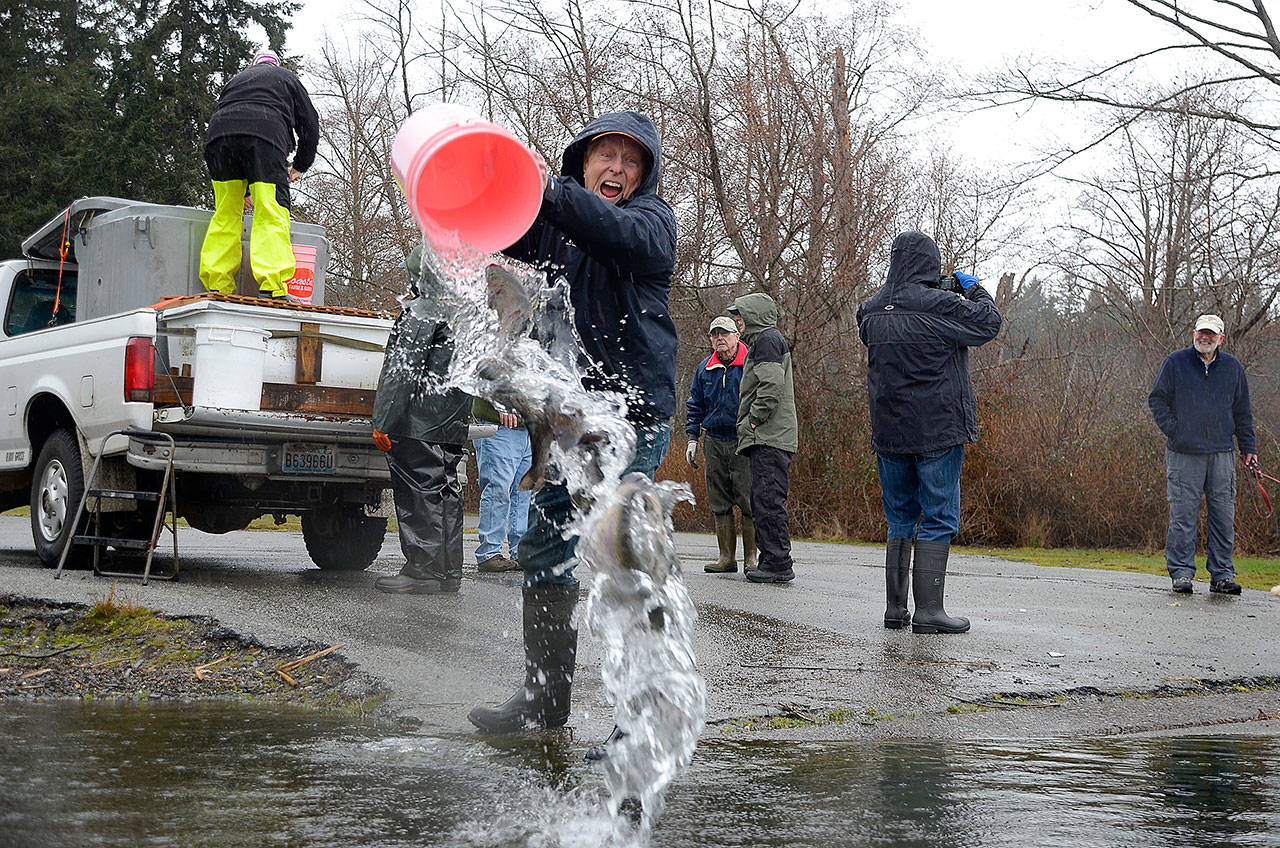The life of a rainbow trout can be short once it’s transported from state hatcheries into the wild.
Four lakes on Whidbey Island welcomed nearly 23,000 new residents this month — and how long they’ll remain alive and flipping is anyone’s guess.
Trout populations in those lakes are expected to start diminishing rapidly come Saturday, April 22.
Even though a great number of lakes around the state are open to fishing year-round, the fourth Saturday in April marks the traditional start of lowland lakes fishing in Washington.
It is a time when hundreds of thousands of anglers from Coupeville to Colfax start chasing after millions of trout stocked by State Fish and Wildlife hatchery crews.
Crews from nearby hatcheries have been scrambling in recent weeks to import trout by the truckfuls.
The lakes on Whidbey and nearby Fidalgo Island will be well represented with fresh plants of catchable-sized trout, giving anglers a wide variety of options.
“People are starting to get interested,” Bob Crouch, store manager at Sebo’s Do-it Center in Bayview, said Thursday.
“We’ve had some customers already. I think it might be a good opening day.”
Deer Lake in Clinton and Goss Lake in Langley both open to fishing Saturday — the only two managed lakes on Whidbey that are bound to a six-month season.
Cranberry Lake, located on North Whidbey inside Deception Pass State Park, and Lone Lake in Langley are both open to fishing year-round.
Deer Lake is often the most anticipated lake on Whidbey with thousands of freshly planted fish, including hundreds of jumbo trout.
Deer was stocked this month with 8,002 rainbow trout between 8-and-11-inches in length, plus 600 additional triploid trout that weigh an average of 1.5 pounds apiece.
Goss, a 53-acre lake that doesn’t allow motorized boats, received 4,000 rainbow trout this month.
The daily limit is five fish at these lakes with no minimum size.
“My favorite lake is Goss. It’s nice and quiet,” Crouch said. “There are cutthroat in there as well as native trout and planters, too.”
Justin Spinelli, a state fish biologist from this region, said he expects excellent openers at Deer Lake on Whidbey and Lake Erie on Fidalgo.
Erie, located three miles south of Anacortes, received 14,000 new trout this week that average about a half pound apiece.
“Goss is a neat one if you’re trying to get away from the crowds and fish opening day,” Spinelli said.
“Deer has pretty decent shoreline access. Goss is pretty much a boat show.”
Cranberry Lake was stocked with 10,000 rainbow trout earlier this month but anglers have had a jump-start on catching them. More trout will be planted there in October.
Lone Lake in Langley is considered Whidbey’s trophy trout lake, allowing only one fish per day that must be 18 inches long and requiring anglers to follow selective-gear rules.
The lake, however, is recovering from a fish die-off last September, when low dissolved oxygen levels caused at least 1,000 rainbow trout to wash up onshore.
Five Western Washington fishing clubs pooled resources to introduce about 450 trout of roughly one pound apiece into the lake in late February.
The state supplemented that with 3,000 smaller trout in March.
Spinelli said he doesn’t expect the privately-donated trout at Lone Lake to start reaching the minimum-keeper size of 18 inches until the fall and predicts it will be the fall of 2018 until the ones supplied by the state get to that size.
Heart Lake on Fidalgo is another lake that Spinelli expects to hear good things from on opening day.
Like Erie, Heart opens Saturday. Heart was stocked with 8,000 rainbow trout this month plus an additional 450 jumbo trout.
Another lake on Fidalgo that anglers should keep on their radar later this spring is Lake Campbell, which is expected to receive 600 jumbo trout in May and also is the best bet on the two islands to catch large catfish.
Pass Lake, located just north of the Deception Pass bridge, is a trophy fly-fishing-only, catch-and-release lake that doesn’t allow motor boats.
Anglers are required to possess a state freshwater fishing license, which costs $29.50 for residents.



